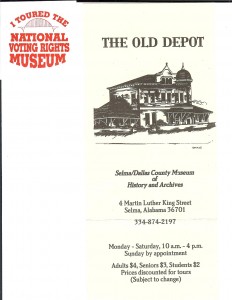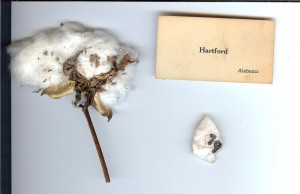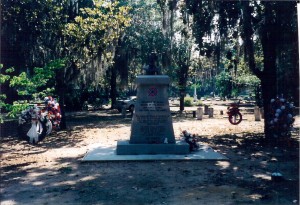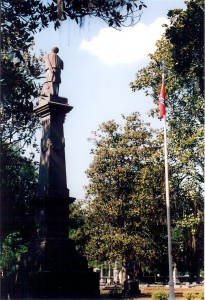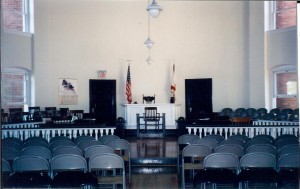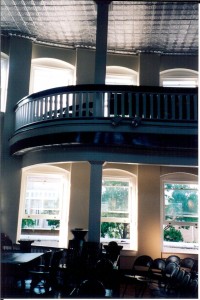We began the day with brunch at the Cracker Barrel, with the lovely parents of a friend who was not on the trip. They offered to put us in touch with their pastor, who had been beaten during the march from Selma to Montgomery. We had planned to go back to the Fitzgerald place, but the brunch gave a later start, so we headed directly for Selma. We had ambitiously reserved rooms in a hotel at the Gulf Coast for the night, so we had a lot of ground (and history) to cover that day. Fortified by the Cracker Barrel breakfast, we set out.
We had chosen to see Selma because of its place in Civil Rights history. In March 1965, civil rights activists attempted to march from Selma to the state capitol in Montgomery to confront Governor George Wallace about voting rights and efforts to prevent them from including blacks. The marches met considerable resistance when they crossed over the Edmund Pettus Bridge, so much so that the bridge itself is a landmark of the struggle.
We arrived in Selma, a town small enough to find one’s way in. We started at the Voting Rights Museum, an independent museum dedicated to the history of the civil rights struggle. The entrance walls contain small notes, the most moving of which came from those who participated in the marches. One of the most compelling ones came from the child of a Viola Liuzzo, who died in her effort to ferry marchers, noting to visitors that the sacrifice was worth it. I have to admit that I doubt I could say the same for a loved one killed by violence. The rest of the museum was equally heartfelt, containing photos of the march from the state police, a time progression of the day, plaster casts of marchers’ feet, a chapel with memorials to those who died in the Civil Rights struggle, and an African corpus of Christ, a reminder of my own time in Africa. There was also Ku Klux Klan paraphernalia and a room honoring women pioneers in voting rights. My friend and I wandered in silence, and I found the museum absorbing because the people it commemorated were so jarringly near in time and place.
From the Voting Rights Museum, we headed to the Old Depot Museum, which was recommended in our guide books. In contrast to the Voting Rights Museum, the Old Depot felt as if the town had opened its collective attic to us. Essentially, there was stuff about everything. Our gentleman guide, a white man, escorted us through confederate memorabilia and Civil Rights displays. The real gem was a series of late 19th century photographs of sharecroppers found in a local person’s stuff. The detail and clarity in them were so remarkable that I could have looked at them for hours. Our guide gave us samples of cotton, old train tickets, and Indian arrow heads. We talked with the elderly and garrulous carver, a black man, about life while he worked.
Our guide chatted about the difficult reality of being a freed slave in Reconstruction, of trying to support yourself with few skills, and the attractiveness of returning to the plantation. We worked our way upstairs and the guide chatted with us about politics in the South, affirming what our companions at brunch had already told us: that politicians exploit racial feelings on both sides to gain power, but generally find ways to compromise in the end. He opined that Gov. Wallace had forced the showdown over voting rights in Selma in order to prevent marchers from getting into Montgomery, which has left a mark on the town ever since. He also admitted that he, too, once thought segregation made sense, and it took time and consciousness-raising to change his mind. As he spoke, I felt a bit of discomfort about the conversation. It is one thing to visit museums of the struggle, another to discuss it with people who lived it. Over brunch, my African-American companions were initially hesitant to speak with me freely about Civil Rights because they did not know where I stood as a white woman, and now I was similarly nervous about what the guide might share in front of my African-American traveling companion. In the end, I was simply grateful that everyone spoke openly.
We emerged from the museum into the heat and light. Our guide had informed us that ice cream shops had not proved to be good business in this part of Alabama, and the New South had lost its taste for leisurely glasses of lemonade in the afternoon. My traveling companion and I surmised that life has sped up and domestic life has diminished with that, but we developed our first trip joke: Civil Rights had killed lemonade.
Next, we headed out to the Confederate cemetery, where we viewed row upon row of Confederate dead now buried alongside their wives.
The was a controversial monument there, a confederate memorial that our brunch companions had told us was erected in a historically Black neighborhood, but was moved to the cemetery after considerable protest. Our guide told us that the original site was also the location of an old Confederate hospital. We were learning that, dead lemonade rituals aside, the New South also retains fresh historical landmines. We wandered around the cemetery, taking in the shady trees covered in Spanish moss, and then headed on our way.
Our next stop was Monroeville, where Truman Capote and Harper Lee played together as children. We had heard that the town puts on summer performances of her book, To Kill a Mockingbird, using the old courthouse as a stage set. We zoomed away from the historic homes we wanted to see in Selma in an effort to see the play from its start. We arrived in town with an hour to spare, and received a warm welcome, finding a place for us both even though the play was sold out. This gave us time to wander the town square, which had largely closed for the day. Then the play started, with the first half set outside the courthouse, and the second reconvened within the courtroom, which was the basis for the movie set.
From the floor, I had trouble seeing and I longed for a seat in the balcony. However, my traveling company was uncomfortable relegating herself there, particularly since she was the only person of color at the performance that night. After some discussion, we stood in the back to see, and were joined by another woman. The play was well acted by locals, many of whom repeat the parts over the course of years. It was also comprehensive, leaving in most of Lee’s book.
This meant it was late when we headed for the Gulf coast, and we were starving. So we made our first stop at a Burger King, where we discovered that there was a sale on whoppers, which would make it our back-up eatery for the remainder of the trip. As we had been warned by locals, the drive was long, and we arrived in darkness. We confirmed that there were ice cream shops nearby, and collapsed into bed. It was a exhausting day, but a rewarding one for exploring the state.

